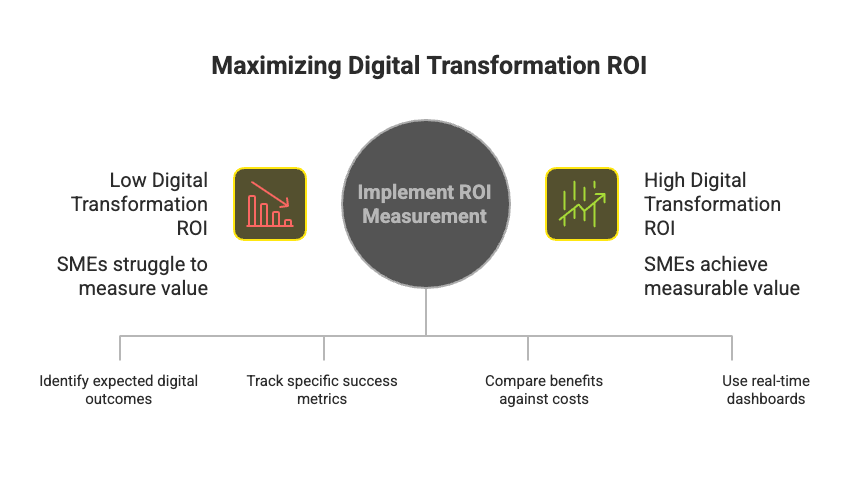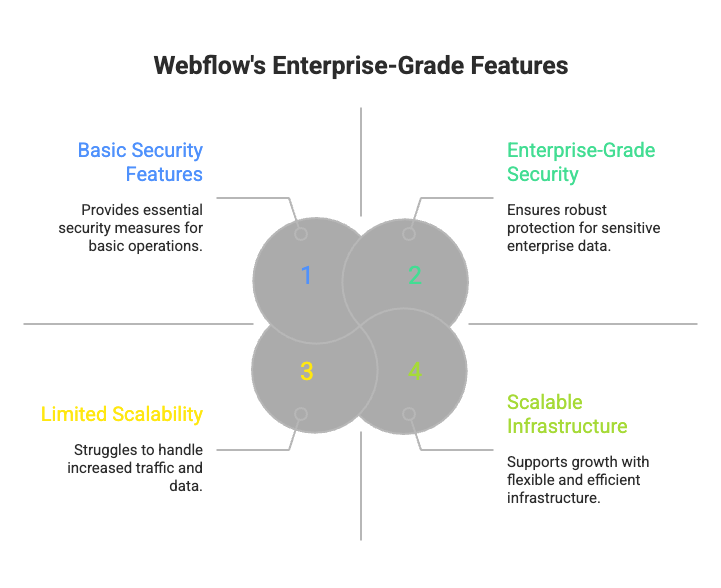In today’s fast-paced business environment, digital transformation is no longer a luxury—it’s a necessity. For Hong Kong’s SMEs, embracing digital transformation can unlock new growth opportunities, improve operational efficiency, and enhance customer experiences. However, many small and medium-sized enterprises (SMEs) struggle to evaluate whether their digital transformation initiatives are delivering measurable value.
Understanding and maximizing the return on investment (ROI) of digital transformation is critical for ensuring long-term success. This is especially true in Hong Kong’s highly competitive business ecosystem, where SMEs must justify their investments in technology and demonstrate tangible results.
This blog will serve as a blueprint for Hong Kong SMEs, guiding them on how to effectively measure, optimize, and maximize the ROI of their digital transformation initiatives. From selecting the right KPIs to real-world case studies, we’ll show you how to make your digital transformation journey a success while ensuring every dollar is well spent.
Why ROI Is Critical for Digital Transformation
1. Justifying Investments
Digital transformation initiatives often involve significant upfront costs, such as adopting low-code platforms, integrating AI tools, or migrating to the cloud. Clear ROI metrics help businesses justify these investments to stakeholders.
2. Aligning Strategy with Business Goals
Measuring ROI ensures that digital transformation efforts are aligned with key business objectives, such as increasing revenue, improving efficiency, or enhancing customer satisfaction.
3. Identifying Bottlenecks
Tracking ROI highlights areas where digital transformation efforts may be underperforming, allowing businesses to adjust their strategies for better results.
4. Driving Continuous Improvement
ROI metrics provide insights into the success of transformation projects, enabling SMEs to refine their processes and adopt future-proof solutions over time.
How to Measure Digital Transformation ROI for Hong Kong SMEs
To evaluate the ROI of digital transformation, businesses must first define their goals, metrics, and success criteria. Here’s a step-by-step approach:
Step 1: Define Clear Objectives
Before implementing any digital transformation strategy, SMEs must identify their expected outcomes. Common objectives include:
- Revenue Growth: Increasing sales through digital channels or improved customer engagement.
- Cost Savings: Automating manual processes to reduce operational expenses.
- Customer Satisfaction: Enhancing the customer experience by streamlining interactions and personalizing services.
- Market Expansion: Entering new markets through digital platforms like e-commerce or SaaS models.
Example:
A Hong Kong retail SME aims to increase online sales by 20% by implementing an e-commerce platform within six months.
Step 2: Select Key Performance Indicators (KPIs)
Measuring ROI requires tracking specific digital transformation success metrics that align with your business goals.
Common KPIs for Digital Transformation
- Customer-Focused Metrics:
- Net Promoter Score (NPS): Measures customer satisfaction and loyalty.
- Customer Retention Rates: Tracks how well your digital solutions retain customers.
- Conversion Rates: Measures the percentage of website visitors who complete a desired action, such as making a purchase.
- Operational Efficiency Metrics:
- Process Automation Rate: Tracks the percentage of manual tasks automated by digital tools.
- Time-to-Market: Measures how quickly new products or features are launched using digital solutions.
- Employee Productivity: Tracks improvements in employee output after implementing digital tools.
- Financial Metrics:
- Cost Savings: Calculates reductions in operational expenses.
- Revenue Growth: Measures increased revenue attributed to digital transformation.
- Return on Investment (ROI): Compares the total benefits of digital transformation against the costs incurred.
Example:
A logistics SME in Hong Kong implemented an IoT-based fleet management system. They tracked KPIs such as fuel savings (cost savings) and on-time delivery rates (customer satisfaction) to measure success.
Step 3: Calculate ROI
ROI can be calculated using the formula:
ROI (%) = [(Net Benefits – Costs) / Costs] x 100
Breaking It Down:
- Net Benefits: Include increased revenue, cost savings, or productivity improvements.
- Costs: Include software licenses, training, hardware, and implementation expenses.
Example Calculation:
A Hong Kong SME invests HKD 500,000 in a low-code platform to automate manual workflows, saving HKD 300,000 annually in labor costs and generating HKD 200,000 in additional revenue.
ROI = [(300,000 + 200,000 – 500,000) / 500,000] x 100 = 0% in Year 1 but 100% in Year 2
This calculation shows how ROI improves over time, as initial costs are offset by cumulative benefits.
Step 4: Monitor Progress with Dashboards
Use real-time dashboards to track KPIs and ROI metrics. Platforms like Power BI, Tableau, or Webflow CMS can help visualize data and provide actionable insights.
Actionable Insight:
A digital marketing SME in Hong Kong used Google Analytics to track website traffic, conversion rates, and ROI from a content marketing campaign. The dashboard helped them identify which strategies delivered the best results.
Real-World Case Studies: Digital Transformation Success in Hong Kong
Case Study 1: Retail SME Expands Online Sales
A Hong Kong-based fashion retailer implemented a low-code e-commerce platform to expand its digital presence. By integrating payment gateways like PayPal and offering personalized product recommendations, the retailer achieved:
- 30% increase in online sales within six months.
- 25% reduction in cart abandonment rates through an optimized checkout process.
Case Study 2: Logistics SME Improves Efficiency
A logistics SME adopted an IoT-enabled fleet management system to optimize delivery routes and reduce fuel consumption. Results included:
- 15% decrease in fuel costs.
- 20% improvement in delivery times, leading to higher customer satisfaction.
Case Study 3: Digital Marketing Agency Enhances Client ROI
A Hong Kong-based marketing agency used AI-driven tools to automate campaign performance tracking and reporting. Results included:
- 50% reduction in reporting time, allowing staff to focus on strategy.
- 20% increase in client retention rates due to improved campaign results.
Common Challenges in Measuring Digital Transformation ROI
While ROI is critical, many SMEs face challenges in measuring and optimizing it:
1. Lack of Clear Goals
Without defined objectives, it’s difficult to track success. Always align digital initiatives with specific business outcomes.
2. Underestimating Costs
Many SMEs overlook hidden costs, such as ongoing maintenance, training, and system upgrades.
3. Difficulty Quantifying Intangible Benefits
Metrics like customer satisfaction or brand loyalty can be challenging to measure but are equally important.
Solution:
Use customer feedback surveys and NPS scores to quantify intangible benefits.
Tips for Maximizing Digital Transformation ROI
To ensure your digital transformation efforts deliver maximum value, follow these actionable tips:
1. Start Small, Scale Gradually
Begin with pilot projects to test the effectiveness of new technologies before scaling them across the organization.
Example:
A Hong Kong SME tested a low-code CRM system with one department before rolling it out company-wide, reducing risk and ensuring a smooth deployment.
2. Leverage Government Funding
Take advantage of Hong Kong government funding schemes, such as the BUD Fund or ESS Grant, to offset the costs of digital transformation.
3. Focus on Employee Training
Technology adoption is only as effective as the people using it. Invest in training to ensure employees can fully leverage digital tools.
Example:
A Hong Kong SME conducted workshops on their newly implemented AI-driven analytics platform, boosting employee productivity by 15%.
4. Partner with Experts
Collaborate with digital transformation agencies like RMD HK to develop tailored strategies, select the right tools, and monitor ROI effectively.
5. Continuously Optimize
Regularly review performance metrics and adjust your strategies to improve ROI over time.
FAQs: Measuring Digital Transformation ROI
1. What are the key KPIs for digital transformation in Hong Kong?
Common KPIs include revenue growth, cost savings, NPS scores, conversion rates, and employee productivity improvements.
2. How can Hong Kong SMEs justify digital transformation investments?
By calculating ROI, tracking KPIs, and leveraging government funding, SMEs can demonstrate the tangible benefits of digital transformation.
3. How long does it take to see ROI from digital transformation?
ROI timelines vary depending on the project. While some initiatives deliver immediate results (e.g., process automation), others, such as AI adoption, may take 6–12 months to show significant returns.
Final Thoughts
For Hong Kong SMEs, digital transformation is a critical investment in future-proofing their businesses. By defining clear goals, tracking the right KPIs, and leveraging tools like low-code platforms and IoT solutions, SMEs can maximize their ROI and stay competitive in the Asia-Pacific market.
At RMD HK, we specialize in helping SMEs navigate their digital transformation journeys. From strategy development to implementation, we ensure your investments deliver measurable results and long-term value.



.png)
